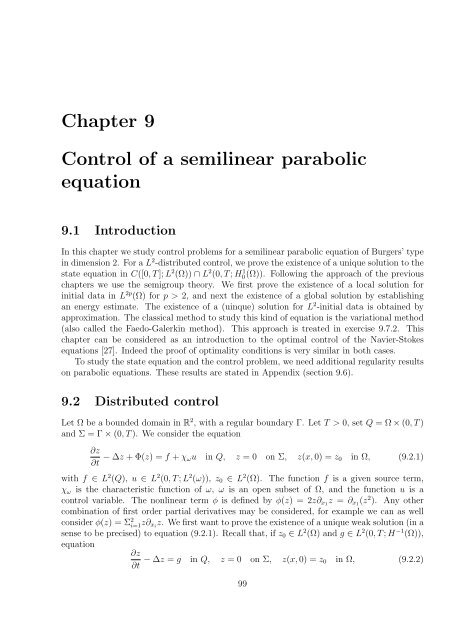Optimal Control of Partial Differential Equations
Optimal Control of Partial Differential Equations
Optimal Control of Partial Differential Equations
Create successful ePaper yourself
Turn your PDF publications into a flip-book with our unique Google optimized e-Paper software.
Chapter 9<br />
<strong>Control</strong> <strong>of</strong> a semilinear parabolic<br />
equation<br />
9.1 Introduction<br />
In this chapter we study control problems for a semilinear parabolic equation <strong>of</strong> Burgers’ type<br />
in dimension 2. For a L 2 -distributed control, we prove the existence <strong>of</strong> a unique solution to the<br />
state equation in C([0, T ]; L 2 (Ω)) ∩ L 2 (0, T ; H 1 0(Ω)). Following the approach <strong>of</strong> the previous<br />
chapters we use the semigroup theory. We first prove the existence <strong>of</strong> a local solution for<br />
initial data in L 2p (Ω) for p > 2, and next the existence <strong>of</strong> a global solution by establishing<br />
an energy estimate. The existence <strong>of</strong> a (uinque) solution for L 2 -initial data is obtained by<br />
approximation. The classical method to study this kind <strong>of</strong> equation is the variational method<br />
(also called the Faedo-Galerkin method). This approach is treated in exercise 9.7.2. This<br />
chapter can be considered as an introduction to the optimal control <strong>of</strong> the Navier-Stokes<br />
equations [27]. Indeed the pro<strong>of</strong> <strong>of</strong> optimality conditions is very similar in both cases.<br />
To study the state equation and the control problem, we need additional regularity results<br />
on parabolic equations. These results are stated in Appendix (section 9.6).<br />
9.2 Distributed control<br />
Let Ω be a bounded domain in R 2 , with a regular boundary Γ. Let T > 0, set Q = Ω × (0, T )<br />
and Σ = Γ × (0, T ). We consider the equation<br />
∂z<br />
∂t − ∆z + Φ(z) = f + χωu in Q, z = 0 on Σ, z(x, 0) = z0 in Ω, (9.2.1)<br />
with f ∈ L2 (Q), u ∈ L2 (0, T ; L2 (ω)), z0 ∈ L2 (Ω). The function f is a given source term,<br />
χω is the characteristic function <strong>of</strong> ω, ω is an open subset <strong>of</strong> Ω, and the function u is a<br />
control variable. The nonlinear term φ is defined by φ(z) = 2z∂x1z = ∂x1(z 2 ). Any other<br />
combination <strong>of</strong> first order partial derivatives may be considered, for example we can as well<br />
consider φ(z) = Σ 2 i=1z∂xi<br />
z. We first want to prove the existence <strong>of</strong> a unique weak solution (in a<br />
sense to be precised) to equation (9.2.1). Recall that, if z0 ∈ L 2 (Ω) and g ∈ L 2 (0, T ; H −1 (Ω)),<br />
equation<br />
∂z<br />
∂t − ∆z = g in Q, z = 0 on Σ, z(x, 0) = z0 in Ω, (9.2.2)<br />
99

















